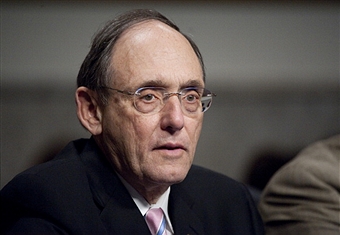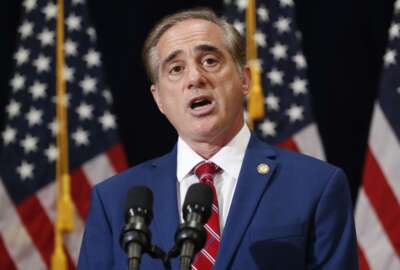

Veterans Affairs Secretary David Shulkin is launching a veterans benefit advisory board to begin a strategic review of the many and diverse programs VA currently...
Subscribe to Federal Drive’s daily audio interviews on iTunes or PodcastOne.
Five days before Veterans Day, the Veterans Affairs Department’s top leader is calling on the veterans community to consider the past 150 years and the vast variety of benefits the department currently provides to those who “have borne the battle” in a completely new way.
“Today … I call for a new way of thinking about benefits,” VA Secretary David Shulkin said Monday during a speech at the National Press Club. “I want to see an ongoing dialogue with stakeholders about rationalizing veterans benefits — a veterans benefit advisory board that can bring clarity to what we’re trying to do for veterans and what’s best and how we can do that in the best way.”
The creation of a new veterans benefit advisory board will help VA focus on what Shulkin described as key aspects of Veterans Benefits Administration programs: providing financial security for those who are severely disabled, providing mental and physical well being to veterans, offering economic and professional opportunities and helping them reintegrate back into civilian life.
“We need more incentives for achieving wellness and independence,” Shulkin said. “This should be a system that focuses on veterans’ abilities, not on their disabilities. VA needs to transform into an organization where we are veterans’ advocates and we facilitate them getting benefits, not being the gatekeeper of benefits decisions.”
“Let me be clear though, this is not about taking away benefits from veterans,” he added. “This is about making benefits work better for veterans and transforming the Department of Veterans Affairs to do better for years and for generations for future veterans. I think they deserve no less than that.”
The speech was a different one for Shulkin, whose public appearances often focus on health care.
“I wanted to challenge myself, and in the spirit of Veterans Day, I’m going to talk about something that I don’t spend as much time as maybe I should talk about, and that is our area of benefits. This is an area that I believe we can do better in. We have a system that … is far too complex, filled with too much bureaucracy.”
Shulkin detailed the history of veterans benefits dating all the way back to the Roman Empire, describing various programs and “a piecemeal development” of laws that previous presidents and Congress have enacted throughout American history.
But despite the vast variety of veterans benefits programs and the myriad of rules and regulations that come with them, Shulkin said he’s found a few points of commonality across history.
“Our country is never really fully prepared for the impact of returning veterans,” he said. “We always seem to be surprised that these people come back and they have all sorts of issues that need our help. The changes in benefits that we’ve seen over these 150 years are always politically contentious, and they’re related to the economic conditions of the country.”
The full scope of veterans benefits has never gotten a full, systematic review, Shulkin said, and previous administrations haven’t thought about the financial impact or the red tape and bureaucratic boundaries that these programs would cause.
“The system, it appears to me, puts VA in an adversarial relationship with veterans, where they have to come to us and ask rather than we are trying to help them,” Shulkin said. “Lastly, I would say the cost projections always fall short. The actual costs of these programs always tend to be more than what’s initially thought.”
Mandatory VA benefits spending has risen by more than $80 billion over the past 30-to-40 years. The department spent $95.3 billion on mandatory benefits in 2017, well above the $13.7 billion total in 1980.
Before 2004, military veterans couldn’t receive Defense Department retirement benefits and VA disability compensation at the same time. But by 2013, 59,000 DoD retirees received concurrent benefits, along with Social Security, which totaled more than $3.5 billion, Shulkin said.
Administrative costs at the Veterans Benefits Administration have gone up by $4 billion — from $1 billion in 2000 to $5 billion in 2017.
“We have to make simpler benefits determinations,” Shulkin said. “Frankly, we’re spending too much on administrative costs and we have to let veterans know what they can expect. They shouldn’t have to constantly be refiling claims to get what they deserve. We have to emphasize service-connection for disabilities so we aren’t compensating veterans for age-related issues. We have to focus benefits on enabling independence so veterans can succeed on their own, because that’s what I think leads towards feeling a sense of well being.”
VA is already beginning to make some changes that would put Shulkin’s vision for veterans benefits into reality.
The department last week launched the Rapid Appeals Modernization Program (RAMP), which lets veterans choose from multiple different paths to resolve pending claims. VA began the 18-month implementation plan when President Donald Trump signed the Veterans Appeals Improvement and Modernization Act into law over the summer, which authorizes a new claims review process.
The goal of RAMP is to give veterans the earliest possible resolution of their pending claims with VBA.
Later this month, the department will begin making VA benefits determinations for military members on the day they leave service, Shulkin said.
And in the future, Shulkin said he wants VA to make instant adjudications, similar to the way consumers can get immediately get their credit scores online or through a mobile app.
Copyright © 2025 Federal News Network. All rights reserved. This website is not intended for users located within the European Economic Area.
Nicole Ogrysko is a reporter for Federal News Network focusing on the federal workforce and federal pay and benefits.
Follow @nogryskoWFED



